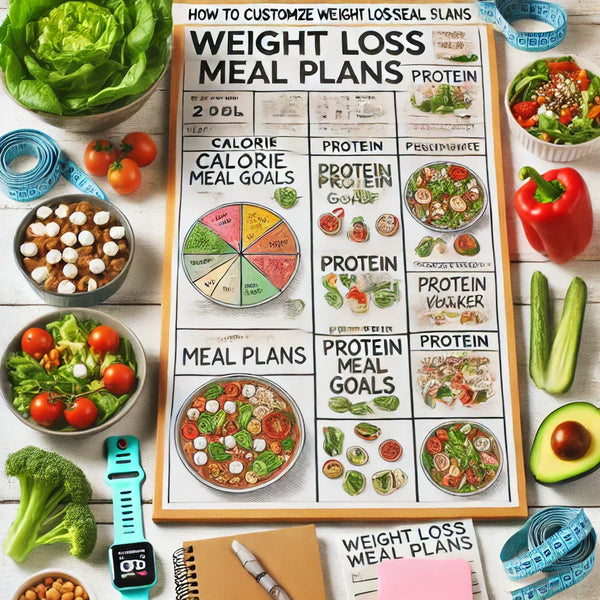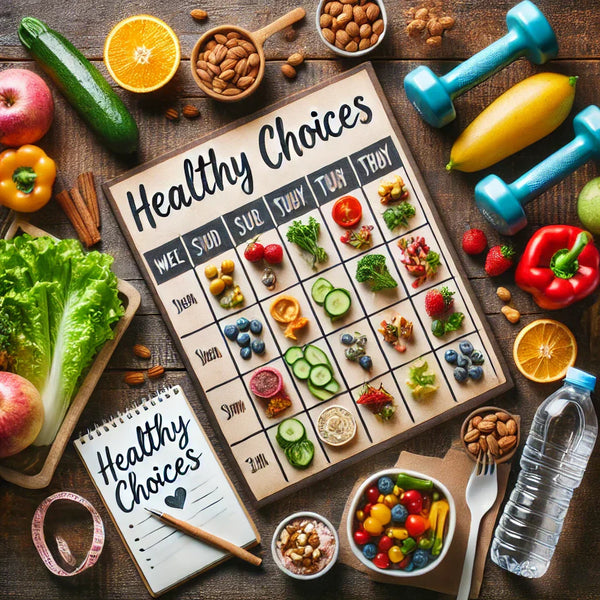How to Customize Weight Loss Meal Plans to Your Goals
by Justine Yolanda

Introduction
Are you struggling to tailor your weight loss meal plan to fit your specific needs? Whether you're new to weight loss or looking to fine-tune your approach, customising your meal plan can be the key to achieving lasting results. A one-size-fits-all approach rarely works, as each person’s body, metabolism, and goals are unique. Personalising your meal plan helps boost your metabolism, manage hunger, and ultimately achieve your goals more effectively.
In this guide, we will show you how to customise your weight loss meal plan according to your specific goals. From understanding your body’s nutritional needs to selecting the right foods and adjusting portion sizes, this step-by-step approach will help you build a healthy meal plan that works for you. So, let’s dive in!
Step 1: Identify Your Weight Loss Goals
Before you begin customising your meal plan, it's essential to identify your specific weight loss goals. Are you looking to lose a significant amount of weight, shed a few pounds, or just maintain a healthy weight? Your goals will directly influence your meal choices and portion sizes.
- Goal 1: Fat Loss – If your primary goal is fat loss, you’ll want to focus on creating a calorie deficit while ensuring you get enough nutrients to keep your energy levels up and preserve muscle mass.
- Goal 2: Sustainable Weight Loss – For those looking for gradual, long-term weight loss, the key is to create a balanced meal plan that includes plenty of whole foods, lean proteins, and healthy fats.
- Goal 3: Health and Fitness Improvement – Some people may not focus solely on losing weight but improving their fitness or overall health. This goal may involve a combination of fat loss, muscle building, and better nutrition for energy and recovery.
Setting clear goals will not only keep you motivated but also guide you in selecting the right foods and adjusting your meal plan over time. Remember, whether your aim is fat loss, muscle gain, or improved health, the right meal plan can help you achieve your desired outcome.
Step 2: Understand Your Body and Its Nutritional Needs
To customise your meal plan, it's crucial to understand your body type, metabolic rate, and daily activity levels. These factors will determine how many calories you need and what macronutrient balance is right for you.
- Metabolism & Activity Level: People with faster metabolisms or those who are highly active may need more calories and protein to support muscle growth and recovery. If you're less active or have a slower metabolism, you may need fewer calories to stay in a calorie deficit for fat loss.
- Body Type: Different body types (ectomorph, mesomorph, or endomorph) have varying nutritional needs. For example, ectomorphs often need higher carbohydrate intake for energy, while endomorphs may benefit from a lower-carb, higher-protein diet to manage fat storage.
- Health Conditions: If you have any underlying health conditions, like diabetes, thyroid issues, or gastrointestinal problems, it’s essential to adjust your meal plan accordingly. Consider consulting a healthcare professional or dietitian for personalised advice.
- Step 3: Select Foods That Align with Your Goal
Once you’ve identified your goals and understood your body’s nutritional needs, it’s time to select the foods that will fuel your journey. Each weight loss goal requires a different approach, so it’s essential to include the right balance of macronutrients.
For Fat Loss:
- Protein: Essential for muscle retention and satiety. Choose lean protein sources like chicken breast, turkey, fish, tofu, or lentils.
- Healthy Fats: Healthy fats help control hunger and support metabolism. Include foods like avocados, nuts (almonds, walnuts), seeds (chia, flaxseeds), and olive oil.
- Vegetables: High in fibre and low in calories, vegetables like spinach, kale, broccoli, and zucchini help with digestion and promote fullness.
For Muscle Building & Weight Loss:
- Higher Protein: If you're aiming to lose fat while building muscle, higher protein intake is essential. Include foods like lean meats, eggs, and Greek yogurt.
- Carbs for Energy: Complex carbs provide long-lasting energy. Opt for whole grains like quinoa, oats, and sweet potatoes.
- Nutrient-Dense Vegetables: Include a variety of vegetables such as bell peppers, cucumbers, and carrots, which provide vitamins, minerals, and fibre to support overall health.
For Energy & Metabolism Boost:
- Complex Carbs: Brown rice, quinoa, and whole wheat pasta provide a steady supply of energy throughout the day without spiking blood sugar levels.
- Healthy Fats: Fatty fish like salmon and mackerel are great sources of omega-3 fatty acids that boost metabolism and support hormonal balance.
- Hydrating Foods: Cucumber, watermelon, and coconut water help with hydration and support the body's detoxification process.
By selecting foods based on your specific goal, you’ll ensure that your body gets the nutrients it needs to perform at its best.
Step 4: Portion Control and Meal Timing
Now that you’ve chosen your foods, it's essential to focus on portion control and meal timing to optimise your results.
Portion Control Tips:
- Smaller Plates: Using smaller plates can trick your brain into thinking you're eating more, which helps with portion control.
- Track Your Food: Use food tracking apps or a food diary to help you stay on top of your portions and prevent overeating.
- Mindful Eating: Slow down and eat without distractions (like TV or phone). This helps you recognise hunger cues and prevent emotional eating.
Meal Timing:
Meal timing can influence your energy levels and metabolism. Here are some popular options:
- 3 Meals + 2 Snacks: Eating smaller, more frequent meals throughout the day helps stabilise blood sugar and prevent overeating.
- Intermittent Fasting: This involves fasting for a set period (e.g., 16 hours of fasting and an 8-hour eating window). This can help control calorie intake and improve fat burning.
Step 5: Track Progress and Adjust
As you follow your custom meal plan, it’s important to track your progress and make necessary adjustments. Weight loss can be slow at times, but tracking progress helps you stay on track.
Tracking Tools:
- Apps: Use fitness apps like MyFitnessPal or Cronometer to track your food intake, macronutrients, and calories.
- Progress Photos: Take weekly photos to visually track your changes and stay motivated.
Adjustments:
- After 2-3 Weeks: If you're not seeing the results you expect, consider adjusting your calorie intake, increasing your activity levels, or tweaking your macronutrient ratio.
- Plateaus: If you hit a plateau, try changing your workout routine or incorporating new foods into your diet to break through the stagnation.
Step 6: Get Support
A weight loss journey can be challenging, but having the right support system makes a huge difference. Surround yourself with people who encourage and motivate you.
- Support Groups: Join online or in-person communities where you can share your progress and receive motivation.
- Professional Help: If needed, consult with a nutritionist, dietitian, or personal trainer to ensure your meal plan is on the right track.
Practical Tips for Customizing Your Meal Plan
- Meal Prep: Prepping your meals ahead of time saves time and ensures you stay consistent with your plan.
- Smart Swaps: Try easy swaps like swapping refined carbs for whole grains or sugary snacks for fruits and nuts.
- Flexible Plan: Keep your meal plan flexible by including a variety of foods, so you don’t get bored with the same meals every day.
Conclusion
Customising your weight loss meal plan to your specific goals is the key to achieving lasting success. By understanding your body’s needs, selecting the right foods, controlling portions, and staying consistent, you can set yourself up for sustainable weight loss. Remember, this is not about extreme deprivation—it's about making smart, healthy choices that align with your lifestyle and long-term goals.
Are you ready to take the next step? Explore Basiligo’s personalised weight loss meal plans, designed to support your unique goals with delicious, balanced meals. Start your journey today and make the first step towards a healthier, happier you.




